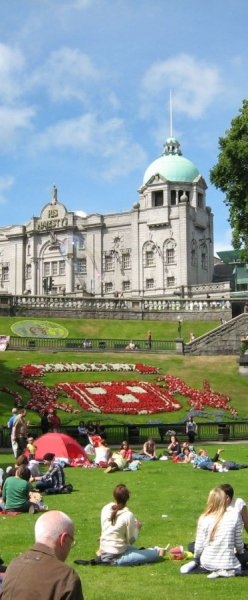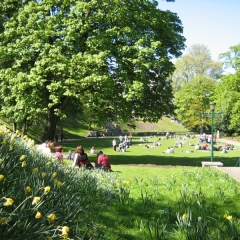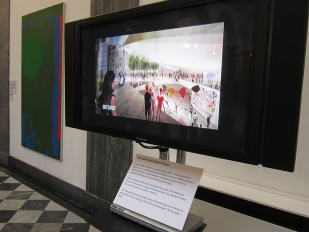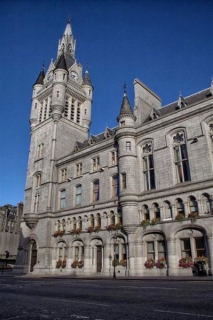
Stephen McCormick recently quit his role as AFC display organiser describing the club as “impossible to deal with.”
By Red Fin Hall.
Recently I wrote about the situation regarding the lack of respect and communication between Aberdeen Football Club, The Supporter’s Liaison Officer within the club, and fans/supporters trying to create a better atmosphere at games via displays etc.
It appears that in some cases they, or more factually correct, people within the club, have, at some point, been actively trying to discourage said displays.
To this end a group of supporters have written an open letter to the board of the club emphasising the need for better communication and co-operation with the supporters. The fans keep getting told, “You are the 13th man.”
Feelings within the supporters at large, is that there is not much confidence that this is true. Even with the prospect of a new stadium coming, Mr Milne only said that there: ‘may be a standing area built within Kingsford’ – not that there would definitely be one. Also there was still no mention of the possibility of there being a bar within, and not just one for the corporate guests, but a public one.
There seems, at this moment in time, a lesser dialogue between the club and the fans than perhaps is perceived.
Below is the open letter.
Dear Duncan George & Stewart
We are writing this to you regarding matters this season and seasons past involving, failure on part of AFC to adequately engage with Aberdeen supporters, treatment of Aberdeen Supporters and in more detail treatment of those in the Merkland Singing Section.
Issues such as, but are not limited to the following areas:
– A reply to questions put to AFC as to why AFC were contacting other clubs in Scotland attempting to discourage match day supporter displays.
– Why the club lied at recent AGM telling the floor they had been in contact with those responsible for the stunning League Cup Final display at Hampden and thanking them when this simply isn’t the case .
– Appointinment of Community Trust chief executive as SLO just to appease UEFA competition guidelines.
– Appointment of a Supporters Liaison Officer (SLO) into the Club without consultation with Supporters groups / Supporters Trust or wider fan base etc
– Failure of said SLO to engage with supporters groups on a day-to-day basis in order to facilitate a more enjoyable and effective match day experience
– Failure of said SLO to engage with supporters groups for major games and to facilitate smooth access to Pittodrie and other stadia to be visited
– Failure of SLO to engage positively with Supporters groups and other clubs in order to facilitate a coordinated and organized approach to maximizing noise generation and fan displays at away games
– Actively and physically segregating, pressurizing and marginalizing of fans in the Merkland Singing section from other fans through use of hostile stewarding, “dead zone” seating strips and general poor attitude shown towards supporters wishing to support their team in a positive manner.
– Misleading information regarding occupancy of Merkland block seating in order to undermine the success of the initiative and prevention of other fans joining the section throughout the game.
– Failure to plan effectively for League Cup Final to ensure effective noise generation in order to back the team effectively by refusing to allocate area for vocal fans .
– Failure of AFC across internal departments (General management, Stadium Access, Ticketing, security etc in order to facilitate an organized and structured and most importantly a respectful approach to AFC supporting individuals working on an unpaid volunteer basis in order to encourage the team positively and to enhance the matchday experience for many people.
The recent League Cup Final showed that AFC has little regard to its fans wider match day experience and even less for creating a spectacle and that the Cup final atmosphere would “look after itself” as one AFC official was quoted as saying.
Anyone who witnessed the Cup final was that those that made the effort and expense of travelling to Glasgow to set up the pre match display done a fantastic effort given that there was no input nor even the respect of reply from AFC from requests from fans made to make the day a spectacle and an positive atmosphere for the duration of the match.
The lack of Aberdeen supporter positive atmosphere generation, particularly after going a goal down (and then more) was very evident.Had there been an area for vocal fans this could have helped create a louder backing for the team.
No doubt AFC will be using footage and photography from the matches with flags, card displays etc for future marketing material, all the while actively discouraging it and disregarding the fact that positive fan interaction does make a difference to the team on the park is wholly unacceptable.
We request the following:
– AFC immediately engage with their staff & AFC fans representatives in order to stop these negative aspects reoccurring
– Appoint a fan elected SLO – one that has a wide understanding or proven background in match day supporter participation, supporter liaison, match day display management.
– Empower the SLO to form a positive working relationship with the Aberdeen support and other clubs respective SLO’s to ensure that the team, the supporters (the customers) are all given the correct priority support to ensure forward progress is made on all levels.
– Ensure that the SLO is meeting the reasonable expectations of the Club, AFC support and wider regulatory bodies such as the Police and other Football Clubs etc.
– The SLO is active in meeting with AFC fans to gather detailed information on future stadia requirements from the “in game” perspective.
We have a supporter in mind, someone who has engaged with the support and more importantly is respected by the support .The same fan has put on many a spectacle at Aberdeen FC games at home and away for the best part of 20 years .He has organised some of the best displays in the UK, helped add colour to AFC centenary events.Always paid tribute to fans who have sadly passed. He is great with the kids and young fans and always gets them involved .
The fans trust him and he’s known throughout the support as he’s always present .
We have a petition that hundreds of fans have signed asking that the club appoint Stephen McCormick as our Supporters Liaison Officer. With the amount of work he has done over the years, dealing with clubs up and down the country, having to deal with the SFA and SPFL he has already proven he has a vast knowledge of modern day football and its supporters.
We look forward to hearing from you in due course.
Signed
Dons fans voice collective.
Also, in my last article regarding this, I mentioned that Stephen contributed out of his own pocket. It has since been pointed out to me that the displays have been fully funded by fan contribution. He is the organiser, and has only contributed as a fan. He wished this to be clear.
- Comments enabled – see comments box below. Note, all comments will be moderated.








